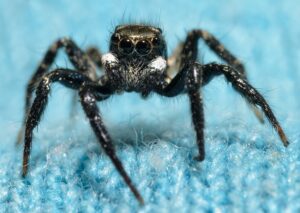Dive into the world of spiders and you’ll notice the Twin Flagged Jumping Spider. It’s known scientifically as Anasaitis canosa and is famous for its unique look and quick moves. Spider fans and experts love studying it. Let’s take a closer look!

The Twin Flagged Jumping Spider, like other jumping spiders, possesses an exceptional set of eyes that grant them almost a 360-degree field of vision. These eyes not only help them in predation but also play a pivotal role during their elaborate mating dances.
The exact appearance of Anasaitis canosa eggs remains a bit elusive. Yet, akin to many jumping spiders, they are likely deposited in a protective silken retreat.
Upon emergence, the young spiderlings resemble miniature versions of the adults. However, they might not fully inherit the trademark markings until reaching maturity.
Anasaitis canosa diverges from the traditional web-spinning spiders. Instead of crafting expansive webs for prey capture, they employ an active hunting strategy, stalking and ambushing their targets. However, they do utilize silk to fabricate diminutive shelters or hideouts.
While the Twin Flagged Jumping Spider does produce venom, it is primarily used for overpowering their prey. For humans, they are not regarded as a threat, with their bite being comparably mild, akin to a bee sting.
Yes, like most spiders, the Twin Flagged Jumping Spider is capable of biting. Nonetheless, their default reaction when encountering humans is to evade rather than attack. Bites usually transpire when the spider perceives imminent danger or is inadvertently pressed.
| Distribution | Mostly found in the southeastern United States. |
|---|---|
| Habitat | They are versatile, often sighted on walls, fences, and plants. |
| Diet | Mainly insects and other diminutive invertebrates. |
| Lifespan | Usually up to a year. |
A standout trait of the Twin Flagged Jumping Spider is its remarkable eyesight, which is among the best in the invertebrate kingdom. This acute vision aids them in spotting potential prey from afar and is instrumental during their intricate mating displays, where males flaunt their striking colors and unique markings to impress females.
Dive into the world of spiders and you’ll notice the Twin Flagged Jumping Spider. It’s known scientifically as Anasaitis canosa and is famous for its unique look and quick moves. Spider fans and experts love studying it. Let’s take a closer look!

The Twin Flagged Jumping Spider, like other jumping spiders, possesses an exceptional set of eyes that grant them almost a 360-degree field of vision. These eyes not only help them in predation but also play a pivotal role during their elaborate mating dances.
The exact appearance of Anasaitis canosa eggs remains a bit elusive. Yet, akin to many jumping spiders, they are likely deposited in a protective silken retreat.
Upon emergence, the young spiderlings resemble miniature versions of the adults. However, they might not fully inherit the trademark markings until reaching maturity.
Anasaitis canosa diverges from the traditional web-spinning spiders. Instead of crafting expansive webs for prey capture, they employ an active hunting strategy, stalking and ambushing their targets. However, they do utilize silk to fabricate diminutive shelters or hideouts.
While the Twin Flagged Jumping Spider does produce venom, it is primarily used for overpowering their prey. For humans, they are not regarded as a threat, with their bite being comparably mild, akin to a bee sting.
Yes, like most spiders, the Twin Flagged Jumping Spider is capable of biting. Nonetheless, their default reaction when encountering humans is to evade rather than attack. Bites usually transpire when the spider perceives imminent danger or is inadvertently pressed.
| Distribution | Mostly found in the southeastern United States. |
|---|---|
| Habitat | They are versatile, often sighted on walls, fences, and plants. |
| Diet | Mainly insects and other diminutive invertebrates. |
| Lifespan | Usually up to a year. |
A standout trait of the Twin Flagged Jumping Spider is its remarkable eyesight, which is among the best in the invertebrate kingdom. This acute vision aids them in spotting potential prey from afar and is instrumental during their intricate mating displays, where males flaunt their striking colors and unique markings to impress females.